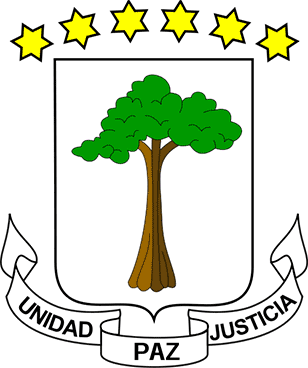
Republic of Equatorial Guinea
MININISTRY OF ECONOMY, PLANNING AND PUBLIC
INVESTMENT
2016 GENERAL STATE
BUDGET PROJECT: PUBLIC
INVESTMENT CHAPTER V
Explanatory Memorandum of the General State Budget Project 2016
The Public Investment Budget (PIP) is the main Government instrument For the materialization of the National Social and Economic Development Plan (PNDES) adopted by the Government in 2008, after the Second National Economic Conference, with the following objectives:
- Diversification of the economy, moving from an oil production and derivatives dependent economy to a fully diversified one.
- Improving social welfare through a progressive increase of Equatoguineans’ access to basic social services.
- Turn Equatorial Guinea into a sub regional centre of prosperity.
Since during the First Phase (2008-2010), PIP was primarily devoted to the construction of basic infrastructure benefiting economic diversification, in this Second Phase, PIP 2016 must prioritize Productive and Social sectors for the achievement of PNDES objectives. Proof of this are the various reports from international agencies that annually review Equatorial Guinea’s economy; the Evaluation Report of Plan Horizon 2020 First Phase; the conclusions contained in reports of the different seminars and conferences that the Government has been organizing to ensure an effective implementation of Plan Horizon 2020 Second Phase, such as the Symposium on the Diversification of Equatorial Guinea’s Economy; and advisory conversations with the World Bank, the African Development Bank and the Bank of Central African States.
However, in the current context of economic recession caused by the sharp drop in oil prices in the international market and the subsequent descent of State revenues forecast (primary financing source of PNDES), the rationalization of Public investment has been imposed to achieve the still outstanding objectives, meaning that the public investment programming should be rigorous, binding with the achievement of PNDES objectives. This means that public investment budget must be sincere, reflect the actual Government public investment programming and developed following modern budget schemes oriented to results.
Therefore, PIP 2.016 main objectives are the following:
- To ensure the provision of public services, through projects that improve social welfare.
- To consolidate the conditions that ensure the development of the productive sector.
- To demonstrate the involvement of the public investment budget with the implementation of the Second Phase of PNDES.
Indeed, public investment, as the main engine of development in Equatorial Guinea, is supported by the creation of modern infrastructure that has transformed the economy of the country, in particular during the period 2008-2012. In consistency with PNDES, the greatest effort has been made in transport infrastructure which allowed, at the end of a decade, the establishment of a national network of highways connecting the whole national geography. Thus, to date, there is a 2,484 km paved road network and 1,372 km of secondary roads. This puts Equatorial Guinea at the head of the African continent in terms of paved roads density. In addition, there are 10 ports and 5 airports that make up the air, sea and river transport logistic infrastructure. Taking into account our geographical configuration, the country achieves this way, the logistic conditions for optimization of transit of goods and people.
Furthermore, in the field of drinking water and basic sanitation, many projects have been executed and major projects on drinking water supply, environmental sanitation, waste water treatment, and recycling plants are underway. 67% of the population has access to improved water sources and 63% has access to basic sanitation systems.
In housing, 12,815 homes are currently under construction and other 4,316 have already been built. Simultaneous with the construction of these houses are the construction of other urban facilities representing significant progress in infrastructure: road network, pipeline as well as maritime equipment, markets parks and churches, among other projects. Also in recent years, there has been investment in construction, rehabilitation or modernization of 40 health centres, 18 hospitals, 5 polyclinics, 7 neonatal services and 7 centres of blood transfusion and oxygen therapy.
In the electrical infrastructure field, the country has to date, a national electricity production of 548,144 MW with 9 power production plants through the country, quadrupling its production in less than a decade. In addition, there are 1,445 km of electronic power transmission lines at national level.
In the field of hydrocarbons, the country has two floors of fuel storage with 33,000 m3 in the continental region. Fuel distributions services have increased with the construction of 21 stations nationwide. In the field of gas, it is worth highlighting gas projects (condensate gas processing plant, LPG propane and butane), methanol plants, the expansion of the plant’s generation of power Turbo Gas in Malabo, the plant of LNG (Tren 1) and modernization and expansion of the butane gas bottling plant.
In terms of connectivity, Back-bone project is developing to bring fibre optics to all municipalities of the country. Also Ceiba’s project to link Bioko Island to the Continental Region is at its final phase. This way, the country has a current capacity of 96 Gb.
Other infrastructures that should be highlighted are those of the fishing sector, Malabo and Bata fish markets, and in the catering business, the rehabilitation and modernization of hotel infrastructure, reinforcing the supply of large hotels. The challenge for Equatorial Guinea lies on: (i) the need to strengthen logistic and economic infrastructure and, of course, (ii) in its operations, maintenance and exploitation.
Important constructions works of new school buildings, some with housing for teachers, have been developed. Primary education centres rose from 792 in 2009 to 857 in 2012, and strategic training centres such as the Centre for Hospitality, Arts and Crafts Formation in Mongomo, the Occupational Training Centre 12 de Octubre, in Malabo, the Polytechnic Training Centre Modesto Gene Roig in Bata, the National Institute of Hydrocarbons in Malabo, and the Professional Electricity Training Centre in Bata, have been built.
This investment increases the attention span of education and health services and prepares human resources for productive diversification processes. However, to achieve its vision 2020, Equatorial Guinea must be massively strengthen its investment in human capital and better align its education system and health needs stated at PNDES Horizon 2020.
Therefore, unlike previous years, the PIP 2016 defines investment priorities from the logic materialization of the PNDES second phase; coordinating and subordinating its programming based on PNDES’s Major Programmes of linkages of construction with its corresponding mechanisms of control and supervision. In short, as it did in 2007, when the Government of Equatorial Guinea adopted one of the first plans of development for economic and social emergency in the African continent, this year, the Ministry of Economy, Planning and Public Investment has adopted the modern practice of “Result Oriented Budget”; this does not imply any violation or contrariety to the Public Investment chapter of the General Law of State Budget precepts as it has being analyzed until this year; in the contrary, it is going to improve its presentation, understanding and utility as a tool to evaluate the implementation of the PNDES.
For the elaboration of the PIP 2016, the following guidelines have been adopted:
- Type of project review.
- Combination of projects with their corresponding control and supervision.
- Project code review and adjustment.
- Review of links with major programmes and projects.
- Definition of weighting and revision of criteria of prioritization.
- Formulation and execution of public investment model prioritization.
- Results review.
In order to ensure sustainability of Public Finances in the medium and long term, as well as macroeconomic stability for the development of PIP 2016, the Ministry of Finance and Budget has set a roof of 1.101 B CFA, shared as it follows:
A. 500 B CFA, for the financing of different infrastructure, social sector and productive projects and programmes, and Central Administration;
B. 100 B CFA, for the Co-Inversion Fund;
C. 400 B CFA, for projects financed with Chinese credit line.
D. 100 B CFA, for transfers of capital to business and local authorities.
GEPetrol 80 B CFA
CEIBA Intercontinenta 10 B CFA
Other businesses 10 B CFA
e. 1 B CFA from external funds for the financing of several projects.

According to the investment ceiling fixed by the Ministry of Finance and Budget for modelling and programming of public investment, the Ministry of Economy, Planning and Public Investment has distributed the budget line items as follows:
a)Flexible component (500.000.000.000), which refers to the variable part of the budget allocations and covering projects and programmes in the infrastructure, social, productive sectors, and Central Administration.
b) flexible component (601.000.000.000), referring to the invariable part of the budget allocations and covering projects and programmes of the co-investment fund, projects financed by the Chinese line of credit, capital transfers to companies and public institutions and external funds to finance several projects.
For PIP 2016 prioritization of projects, the following criterion has been established:
1. Criterion of projects that stimulate the economy: for this criterion the level of project execution has been used as approximate variable. In this sense, all projects close to end have been prioritized, assigning outstanding balances for their coming into operation so that they can have the expected multiplier effect on the economy and comply with Major Programmes.
2. Criterion of projects that strengthen and expand service provision to the population: in this criterion, prioritization is determined by the project type (acquisition, expansion, construction, equipment, studies and design, complementary works, provision of services, production and supervision), giving priority to those that ensure provision of social services.
3. Prioritization according to Major Programmes: prioritized programmes are those associated to Major Programmes, in order to adjust the PIP 2016 to the second phase of PNDES, i.e. projects of productive and social sectors. In addition, projects that strengthen and consolidate the achieved objective of the PNDES first phase are prioritized.
Our goal is that investment prioritization is given ensuring spending quality and making progress on PNDES Horizon 2020 objectives, so that investment decisions are made to improve the well-being of the population. For that purpose, we have advanced a technical exercise of project prioritization using simple and objective tools, as described below:
I. The criteria:
For this exercise, three criteria to take into account were established:
1. The level of progress in the project implementation: it is considered that a project to which resources have been invested, and it is close to its end must be given priority in the allocation of resources, in contrast to a project that is starting or has not advanced significantly in its implantation.
2. The type of main activity carried out by the project: aiming to consolidate the services provided, projects that guarantee the effectiveness of past investment such as projects of completion of works, provision of services and complementary works necessary for the use of infrastructure created, are considered to have higher priority.
3. The largest programme to which the project contributes: according to PNDES 2020 vision, we are in the emergency phase. We have moved from the transformation phase where the creation of infrastructure for competiveness was a priority, to a phase where we must ensure adequate life standards for the population.
II. Scores and weighing
Once the criterion was established, a score was defined to qualify each project:
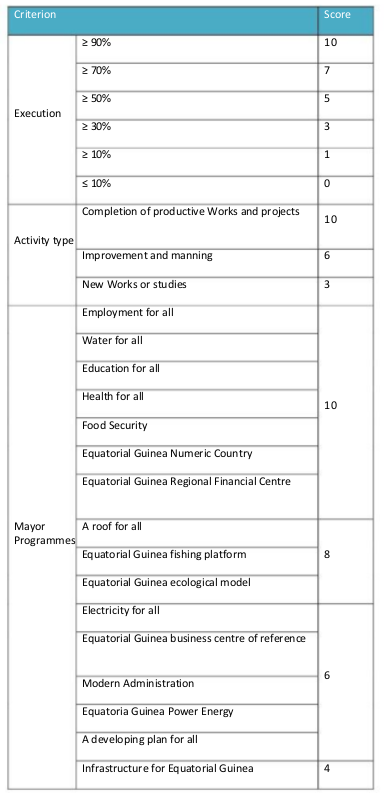
It was also considered that among the three criterions, some should have greater importance therefore, a weighting to apply the scores was defined:
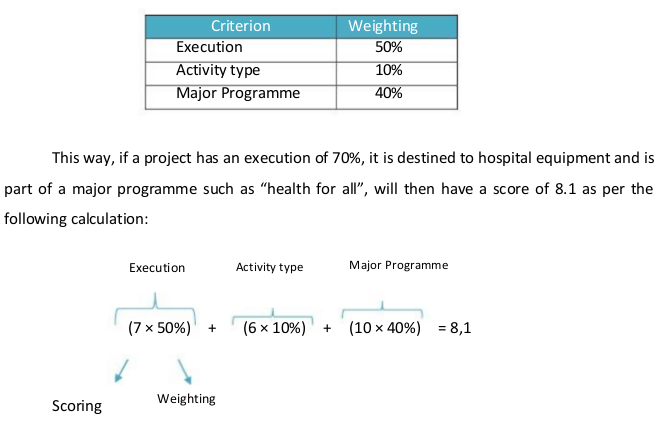
III. Inflexibilities
In addition, it is necessary to take into account projects that support commitments that cannot be stopped from being financed such as projects developed with external funds and co-investment fund transfer to companies and public entities like GEPetrol or Ceiba Intercontinental. These projects are directly assigned a score of 10 points.
IV. Budget availability cutting
Once scores have been calculated and inflexibilities included, projects are sorted according to their qualification and higher scored projects are prioritized for resource allocation. According to budget availability, for PIP 2016, projects that obtained a scores greater than or equal to 6.2 were prioritized.
2016 PUBLIC INVESTMENT BUDGET
Distribution by Major Programmes
Millions of CFA
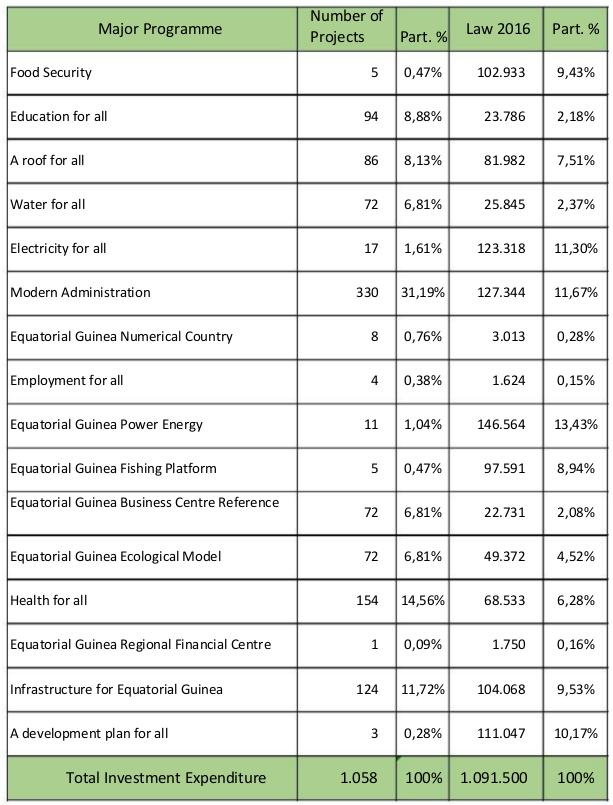
At sectoral level, this classification of the PIP, based on its relationship with major programmes, is presented as follows:
Public Investment Budget 2016
Distribution by Sector & Subsector
Millons CFA
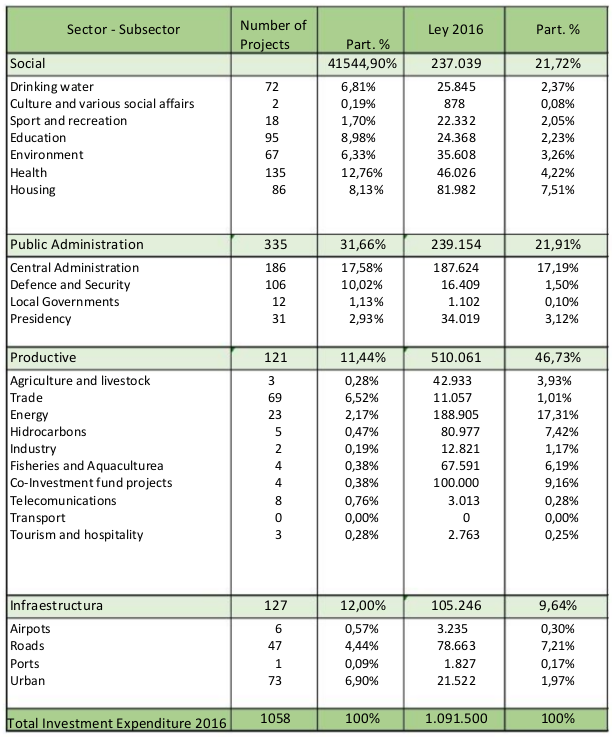
At Institutional level, as it is shown below, it can be seen that Public Works and Infrastructure concentrate the greater budgetary allocations. Note that the departments that largely group budgets are Public Works and Infrastructure, Mines, Industry and Energy, Economy, Planning and Public Investment, Agriculture and Forestry, and Fisheries and Environment; as they are included in different major programmes that have higher budgetary weight assigned.
2016 PUBLIC INVESTMENT BUDGET
Distribution by Ministry
Millons CFA
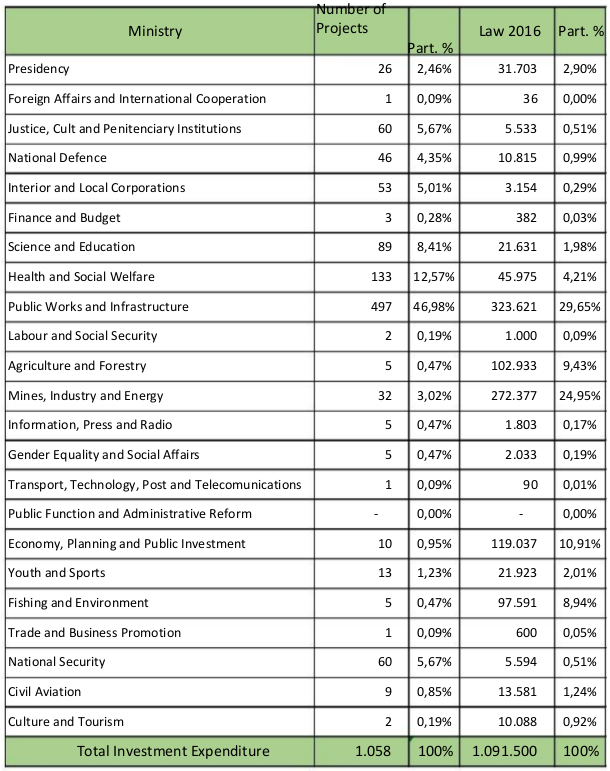
It is significant to emphasize that when modelling and programming public investment, the MEPIP considers that it is important to leave a margin of discretion to political will in order to deal with development challenges that may arise. This margin is scheduled within the flexible component as, for the inflexible component, the MEPIP has partial information available.
In this sense, it all can be seen at the table below:
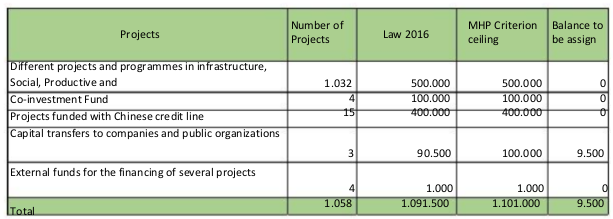
From the 1.1 billion ceiling of public investment by the Ministry of Finance and Budget, 0.5 billion are scheduled in the flexible component.
Malabo, August 2015
